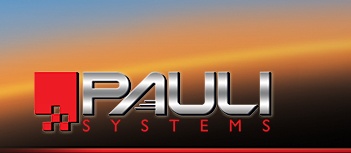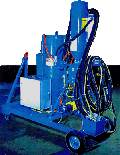Why Use Dry Stripping
[ Painting a Greener Future ]
Paint Booths:
The aircraft chemical depainting industry is losing a common stripping tool and has regulations that required compliance by September 1, 1998. Depainting facilities are forced to alter their practices to comply.
Both the Environmental Protection Agency (EPA) and the Occupational Safety and Health Administration (OSHA) are working together to remove hazardous chemicals from the workplace for a safer future and a cleaner planet. The major hazard, methylene chloride, the primary ingredient in most solvents that remove aircraft paint is on its way out.
April 1997 OSHA regulations were activated to reduce worker exposure to methylene chloride, a documented carcinogen and by September 1, 1998 all facilities must comply.
Blast Rooms:
Rugged, reliable, and revolutionary, RAM (Recliamable Abrasive Machine) is specifically designed to efficiently blast, recover and reclaim plastic and starch media and provide outstanding performance with conventional abrasive media. All floor hoppers, pressure vessel bottoms and dust collector hoppers have slopes of 60 degrees from horizontal for complete discharge of plastic, starch and other media.
[ Why use Dry Stripping ]
- Reduce cost
- Be 100% environmentally clean and comply with new EPA and OSHA regulations
- Remove your company from the regulatory nightmare associated with chemicals
- Eliminate water and its treatment as a consideration in the stripping process
- Eliminate worker exposure to hazardous solvents
- Eliminate air pollution: emit zero HAP's and zero VOC's
- Eliminate water pollution
- Eliminate potential airframe damage from chemicals
- Eliminate fire danger from stripping airframes with flammable liquid
- Generate zero hazardous waste by recycling dry media
- Strip thick paint films nearly as easily as thin
- Strip paint from composite surfaces with the same process used for metals
- Obtain a superior paint job with improved paint adhesion
- Reduce flow time
SAND BLASTING-WHY NOT? click to read more
[ Costs: Dry vs. Chemical Stripping ]
Lockheed
Upon stripping C-130 airframes with plastic media, Lockheed Aircraft Service Company reported a savings of 60% on man hours and 50% savings on flow time. The RAM dry stripping system eliminated costs of treating 60,000 gallons of contaminated water and disposing of 5 drums of sludge with the previous chemical depainting process.
TAT European Airlines
An analysis reported a 30% savings with RAM dry media over methylene chloride based chemicals. Composites were stripped with the same process as metal and rinse water treatment was eliminated. A single strip and paint facility produced excellent paint jobs.
British Aerospace, Warton Aerodrome
A study concluded that the stripping cost per square meter of printed surface is £14.73 for chemical stripping vs. £2.72 for dry stripping
Helicopters
A large civilian helicopter operator replaced 6 workers previously chemically stripping components with one operator and a RAM 31 Dry Media Cabinet (above). Cost of equipment payback was measured in weeks.
[ The environmentally safe Dry Media Process ]
RAM systems not only comply to the new EPA/OSHA regulations, they also make paint removal and media recycling a breeze.
The process is simple. An operator masks areas not to be stripped and proceeds to remove surface coatings by abrasive blasting the surface with a low pressure spray of wheat starch. Wheat starch is hard enough to remove paint without damaging aircraft surface materials. When using our optional computerized AccuFlow Metering System, the exact amount of media flow is controlled to maximize operator performance.
Spent media is pneumatically conveyed to the recycling system for separating usable media and cleaning it for reuse. A high efficiency dust collector filters recovery and ventilating air.
No hazardous solvents to dispose of. No operators with acid burns. No failure of high strength steel components. No VOC emissions permits. No thousands of gallons of contaminated water needing treatment. No more temporary fixes with a chemical de jour. Spent starch or plastic media is simply gathered and recycled.
[ Dry Media Solutions large and small ]
RAM Systems come in all sizes. RAM multi-operator systems enable depainting small helicopters and large transports, others clean small components in a Blast Cabinet, and RAM Blast Rooms provide a closed environment to depaint anything from components to helicopter airframes.
[ Dry Media Solutions for Composites ]
RAM 49 SatinStrip is a tool engineered for damage free dry media paint stripping on composite and metal substrates in a closed cycle dust free environment.
In addition to dust free coating removal, RAM 49 SatinStrip offers operators visual process control with wide path stripping that can double production rates.
It's remarkable performace is due to the successful integration of 3 components:
- The VCC-2000 visual closed cycle dust free blast system with illuminated blasting chamber for operator viewing and control
- FanBlast™ wide path nozzle for vastly superior surface protection and higher stripping speed
- AccuFlow™ computerized media flow valve for gradual non-surge start up combined with unmatched media flow rate



